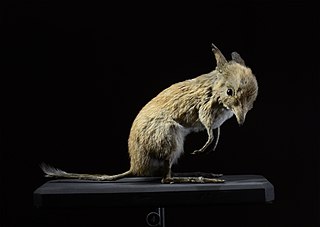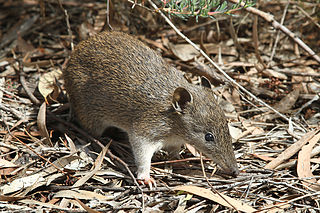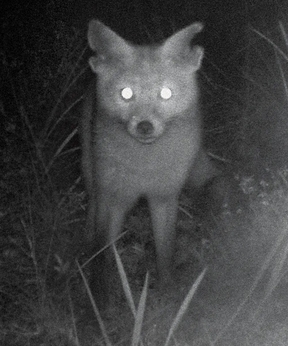
The greater bilby, or simply bilby, is a long-eared, rabbit-like mammal native to Australia. It lives in burrows and is active at night, feeding on insects, fruit, or fungi. The bilby is a marsupial and carries its young in a pouch. Threats include habitat loss, disease, and introduced predators such as foxes. Formerly widespread, bilbies are now restricted to arid parts of northwestern and central Australia.

The order Peramelemorphia includes the bandicoots and bilbies. All members of the order are endemic to Australia-New Guinea and most have the characteristic bandicoot shape: a plump, arch-backed body with a long, delicately tapering snout, very large upright ears, relatively long, thin legs, and a thin tail. Their size varies from about 140 grams up to 4 kilograms, but most species are about one kilogram.

Bandicoots are a group of more than 20 species of small to medium-sized, terrestrial, largely nocturnal marsupial omnivores in the order Peramelemorphia. They are endemic to the Australia–New Guinea region, including the Bismarck Archipelago to the east and Seram and Halmahera to the west.

The eastern barred bandicoot is a nocturnal, rabbit-sized marsupial endemic to southeastern Australia, being native to the island of Tasmania and mainland Victoria. It is one of three surviving bandicoot species in the genus Perameles. It is distinguishable from its partially-sympatric congener – the long-nosed bandicoot – via three or four dark horizontal bars found on its rump. In Tasmania, it is relatively abundant. The mainland population in Victoria is struggling and is subject to ongoing conservation endeavors.

The lesser bilby, also known as the yallara, the lesser rabbit-eared bandicoot or the white-tailed rabbit-eared bandicoot, was a rabbit-like marsupial. The species was first described by Oldfield Thomas as Peregale leucura in 1887 from a single specimen from a collection of mammals of the British Museum. Reaching the size of a young rabbit, this species lived in the deserts of Central Australia. Since the 1950s–1960s, it has been believed to be extinct.

Chaeropus, known as the pig-footed bandicoots, is a genus of small marsupials that became extinct during the 20th century. They were the only members of the family Chaeropodidae in order Peramelemorphia, with unusually thin legs, yet were able to move rapidly. Two recognised species inhabited dense vegetation on the arid and semiarid plains of Australia. The genus' distribution range was later reduced to an inland desert region, where it was last recorded in the 1950s; it is now presumed extinct.

Perameles is a genus of marsupials of the order Peramelemorphia. They are referred to as long-nosed bandicoots or barred bandicoots.

The marsupial family Peramelidae contains the extant bandicoots. They are found throughout Australia and New Guinea, with at least some species living in every available habitat, from rainforest to desert. Four fossil peramelids are described. One known extinct species of bandicoot, the pig-footed bandicoot, was so different from the other species, it was recently moved into its own family.

The western quoll is Western Australia's largest endemic mammalian carnivore. One of the many marsupial mammals native to Australia, it is also known as the chuditch. The species is currently classed as near-threatened.

The southern brown bandicoot is a short-nosed bandicoot, a type of marsupial, found mostly in southern Australia. A subspecies in Western Australia was also known as the quenda in South Western Australia. This subspecies was elevated to species in 2018.

The Western barred bandicoot, also known as the Shark Bay bandicoot or the Marl, is a small species of bandicoot; now extinct across most of its former range, the western barred bandicoot only survives on offshore islands and in fenced sanctuaries on the mainland.

The long-nosed bandicoot, a marsupial, is a species of bandicoot found in eastern Australia, from north Queensland along the east coast to Victoria. Around 40 centimetres (16 in) long, it is sandy- or grey-brown with a long snouty nose. Omnivorous, it forages for invertebrates, fungi and plants at night.

Crash bandicoot is an extinct bandicoot, known from fossils located at the Riversleigh World Heritage Area in northeast Australia.
Liyamayi dayi is a mammal species of the Thylacomyidae family known from fossils located at the Riversleigh World Heritage Area in northeast Australia. The discovery of the specimens was identified as deposited around fifteen million years ago, revising the earliest record of this peramelemorphian lineage from those of species that existed around ten million years later.

Rambo was the name given to a feral red fox that survived for more than four years in a fenced wildlife conservation area in the Pilliga forest, New South Wales. Rambo was regularly photographed by camera traps but evaded all attempts to trap, poison, or shoot him, delaying the planned reintroduction of several threatened mammal species. He was named for John Rambo, the main character in the 1982 film First Blood.













